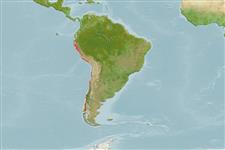Teleostei (teleosts) >
Atheriniformes (Silversides) >
Atherinopsidae (Neotropical silversides) > Atherinopsinae
Etymology: Odontesthes: Greek, odous = teeth + Greek,esthes = suit, something used to wrap (Ref. 45335).
Environment: milieu / climate zone / depth range / distribution range
Ecology
Marine; freshwater; brackish; pelagic-neritic. Tropical; 5°S - 47°S, 85°W - 70°W
South America: Paíta, Peru to Aysén, Chile.
Length at first maturity / Size / Weight / Age
Maturity: Lm ?, range 14 - ? cm
Max length : 18.3 cm TL male/unsexed; (Ref. 122662)
Occurs in schools. Is mainly diurnal. Feeds primarily on the eggs of Engraulis ringens (Ref. 9120).
Wingert, J.M., J. Ferrer and L.R. Malabarba, 2017. Review of the Odontesthes perugiae species group from Río de La Plata drainage, with the description of a new species (Atherinomorpha: Atherinopsidae). Zootaxa 4250(6):501-528. (Ref. 116661)
IUCN Red List Status (Ref. 130435: Version 2024-1)
Threat to humans
Harmless
Human uses
Fisheries: commercial
Tools
Special reports
Download XML
Internet sources
Estimates based on models
Preferred temperature (Ref.
123201): 11.3 - 17.7, mean 14.9 °C (based on 30 cells).
Phylogenetic diversity index (Ref.
82804): PD
50 = 0.5000 [Uniqueness, from 0.5 = low to 2.0 = high].
Bayesian length-weight: a=0.00525 (0.00270 - 0.01019), b=2.99 (2.82 - 3.16), in cm total length, based on LWR estimates for this species & Genus-body shape (Ref.
93245).
Trophic level (Ref.
69278): 4.0 ±0.50 se; based on food items.
Generation time: 1.6 ( na - na) years. Estimated as median ln(3)/K based on 1
growth studies.
Resilience (Ref.
120179): High, minimum population doubling time less than 15 months (K=0.69).
Fishing Vulnerability (Ref.
59153): Low vulnerability (21 of 100).
Climate Vulnerability (Ref.
125649): Moderate vulnerability (36 of 100).
Nutrients (Ref.
124155): Calcium = 275 [165, 498] mg/100g; Iron = 1.79 [1.09, 2.86] mg/100g; Protein = 18.9 [16.6, 21.5] %; Omega3 = 0.249 [0.105, 0.679] g/100g; Selenium = 30.2 [13.6, 68.0] μg/100g; VitaminA = 44.6 [18.6, 105.7] μg/100g; Zinc = 1.66 [1.18, 2.31] mg/100g (wet weight);
